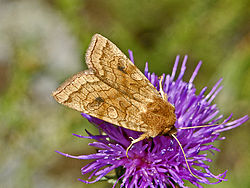- The Phalaena (Noctua) ochreago invalidly described by Esper in 1791 is Tiliacea citrago.
| Xestia ochreago | |
|---|---|
 | |
| Xestia ochreago | |
| Scientific classification | |
| Kingdom: | Animalia |
| Phylum: | Arthropoda |
| Class: | Insecta |
| Order: | Lepidoptera |
| Superfamily: | Noctuoidea |
| Family: | Noctuidae |
| Genus: | Xestia |
| Species: | X. ochreago |
| Binomial name | |
| Xestia ochreago (Hübner, 1790) | |
| Synonyms | |
| |
Xestia ochreago is a moth of the family Noctuidae. [1]
Contents
